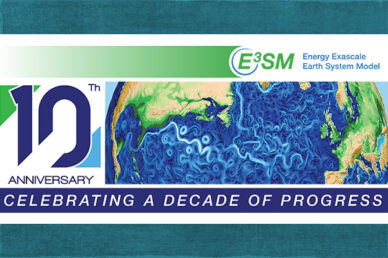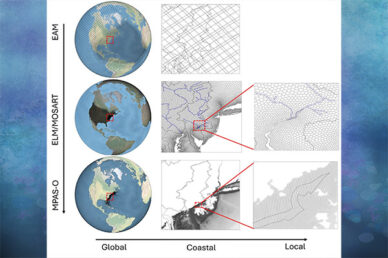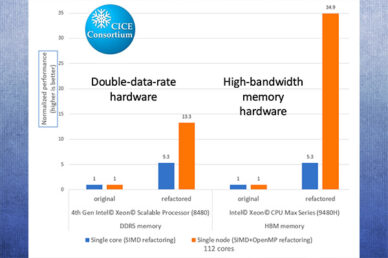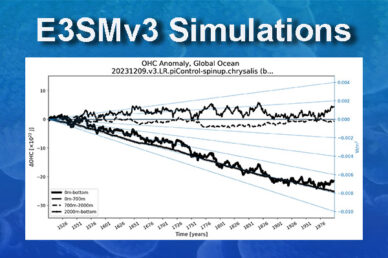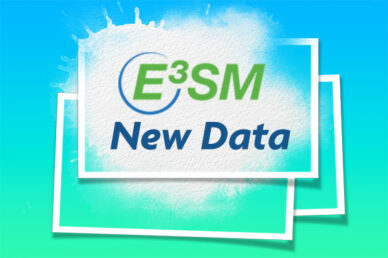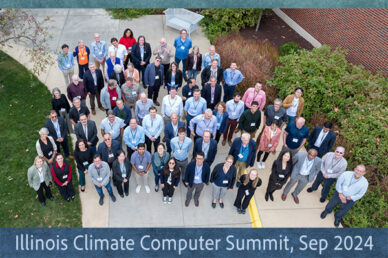Celebrating
A Decade of Progress
The E3SM project began in 2014 with a 10-year vision of modeling the climate on exascale machines. That bold decadal vision was achieved in 2023 and was recognized with the Gordon Bell Prize in Climate Modeling.
We are very proud of what the project team has achieved and look forward to celebrating this decade of progress.
See E3SM Celebrating a Decade of Progres for all articles in the series.
E3SM v3.0
A New Version was Tagged
Version 3.0 of the Energy Exascale Earth System Model was formally frozen and tagged in the project repository in March, 2024. After this date, only maintenance and bug-fix updates will be made to this version.
A patch release v3.0.1 was announced in March. The main purpose of this release is to introduce additional compsets used in v3 simulations and to fix few bugs found in compsets released with 3.0.0.
Users of v3.0 are requested to delay submitting papers that use this new version or any new feature (that may be turned off in the code) until the project submits a publication on its new development (within approximately 6 months to a year), thereby creating a peer-reviewed article for reference. Please read the project Policies and Acknowledge E3SM.
2024 E3SM Tutorial
Online Version
In May 2024, the E3SM project, supported by the US Department of Energy’s (DOE’s) BER EESSD ESMD program held its first in-person tutorial workshop at the National Energy Research Scientific Computing Center (NERSC) at Lawrence Berkeley National Lab in Berkeley, CA. This workshop was designed for new users engaged in currently funded BER’s EESSD projects, and other related DOE projects. The recordings, presentations and practicum material is now available.
Featured Stories
Modeling multi-driver floods for E3SM
The ICoM project aims to improve modeling of coastal evolution >>
NERSC Hackathon on profiling on NVIDIA
Hackathon on profiling on NVIDIA leads to substantial improvements >>
E3SM SCREAM Gordon Bell Prize Video – 2024
2024 E3SM SCREAM publicity video features E3SM Executive Committee >>
Improving Aerosol Radiative Forcing
New cloud microphysics and improved wet removal treatments, improve climate simulations >>
Mesoscale Convective Systems
MCSs remain difficult to replicate without improved model resolution or improved model physics >>
Capturing Finer-Scale Topographic Differences
Topographic variations have substantial impacts on surface hydrologic processes >>
EVP Sea Ice Dynamics Solver
Refactoring the elastic–viscous–plastic sea ice dynamics solver improves performance on CPU & GPU >>
Aerosol Sizes Approximations
Aerosol effects on clouds and radiation are a large source of uncertainty >>
Modeling the Climate at Exascale
The main reference for the EAMxx which evolved from SCREAM was published in JAMES >>
E3SM Patch Release of Version v3.0.1
The first patch release of E3SM for v3.0.0 was released in Oct 2024 >>
xCDAT: a Python Package for Climate Data
A Python Package for Simple and Robust Analysis of Climate Data >>
E3SM All-Hands Presentations – November 2024 Update
All-hands presentations continue to inform scientists as well as the public >>
GEWEX meeting in Japan
The 9th Global Energy and Water Exchanges Open Science Conference, Jul'24, Japan >>
International Summit
Summit on a Computational System for Frontier Earth System Science and Climate Simulation and Projection >>
E3SM Publicity – November 2024 Update
The E3SM Publicity page includes links to recent articles or videos related to E3SM >>
 |
Model |
E3SM is a fully coupled, state-of-the-science Earth system model (ESM) capable of global high definition configuration (25km atmosphere, 12km river model, variable 18 to 6km ocean model, >> |
 |
Data |
Released global Coupled model simulation output data from E3SM target experiments, both the low and high definition configurations. >> |
 |
Tools |
Software applications for coupled and component model diagnostic, evaluation and analysis, data transfer, manipulation, regridding and post processing. Model development tools and unit >> |





